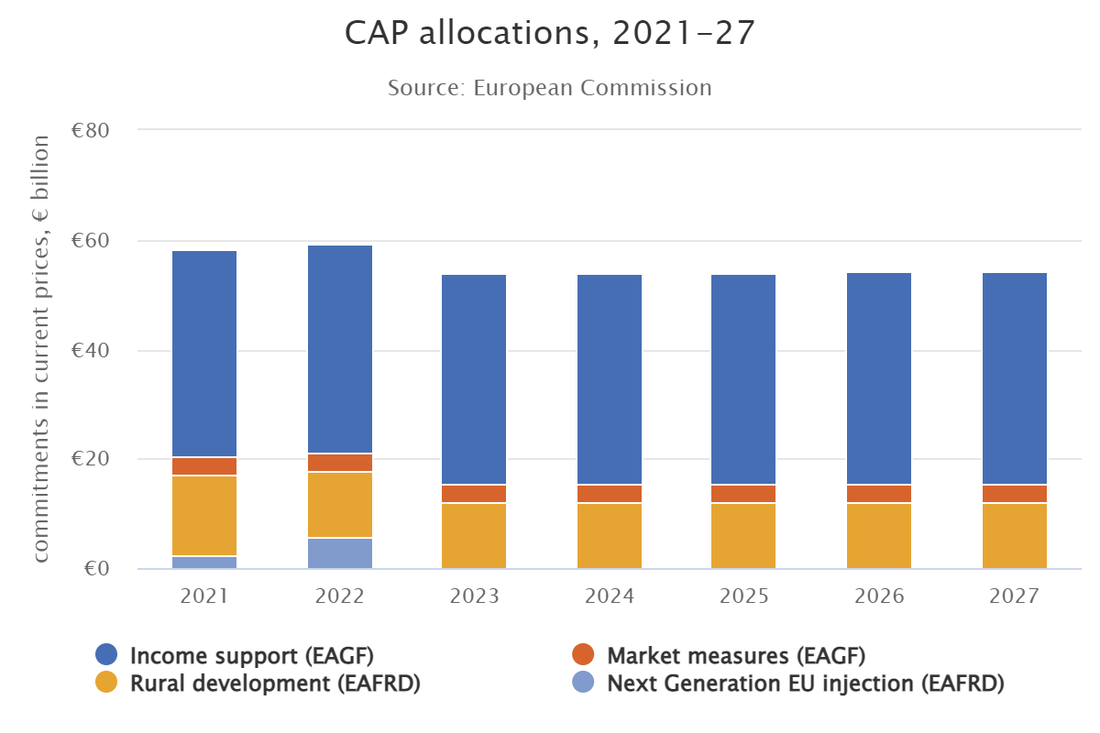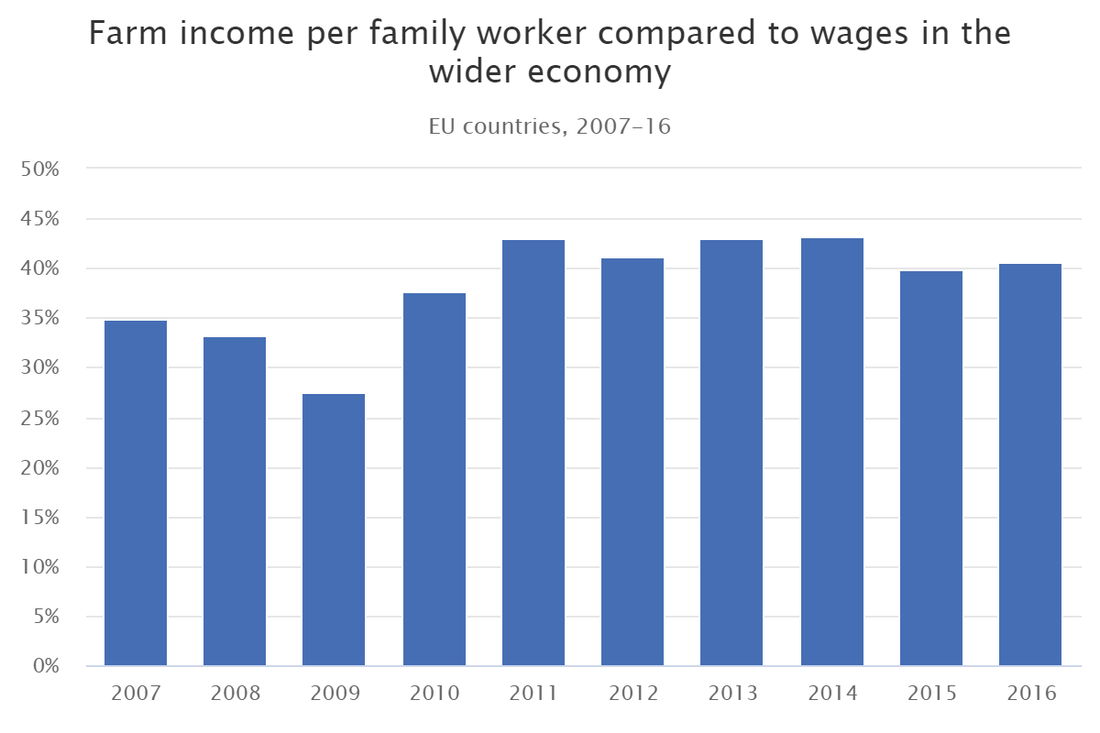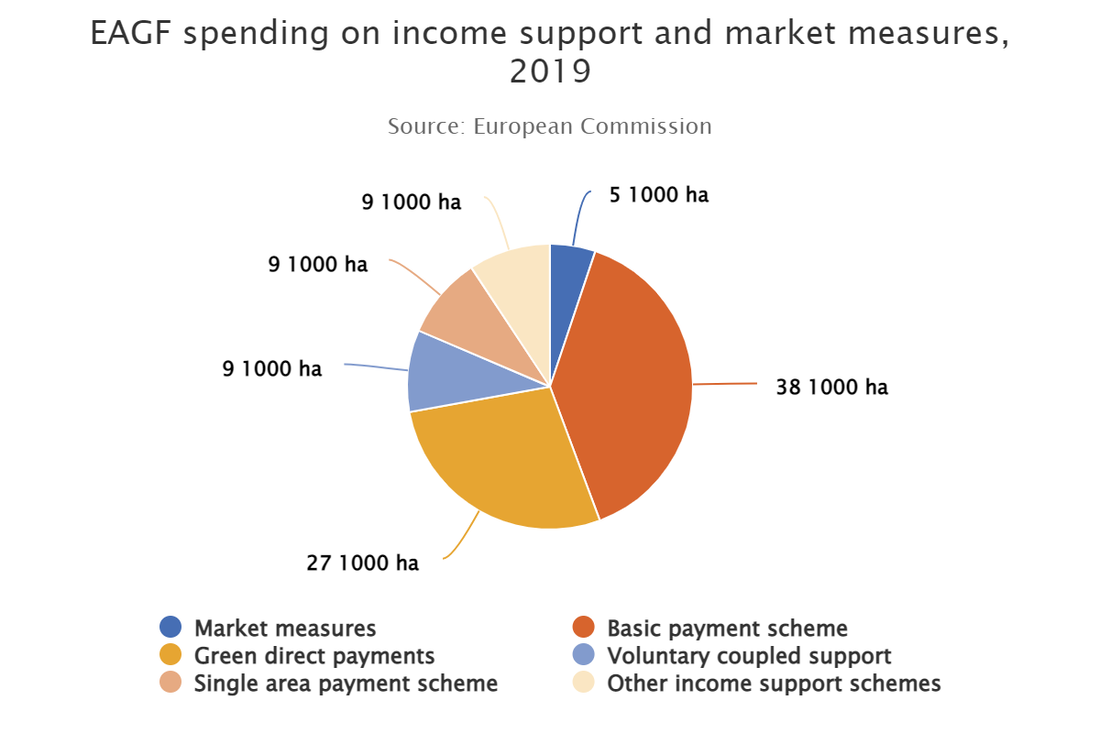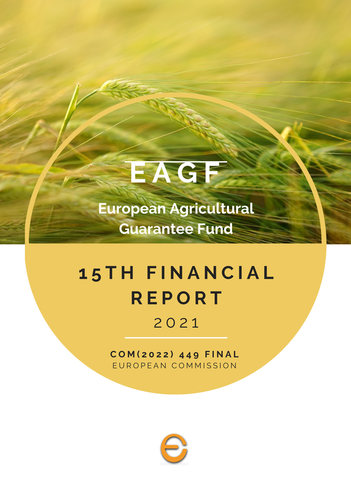|
Brussels, |
|
|
The EAGF (the “first pillar” of the CAP) is one of the two funds for the Agriculture and primarily finances income support for farmers and market measures. The EAGF has an allocation of €291.1 billion. Up to €270 billion will be provided for income support schemes, with the remainder dedicated to supporting agricultural markets. Through the EAGF, EU countries must offer:
EU countries can also use the EAGF to fund specific schemes to help small and medium sized farms, farmers who operate in areas of natural constraint, and sectors undergoing difficulties. The EAGF also funds measures to support and stabilise agricultural markets. These measures operate as part of the Common Market Organisation. |
Income support
The EAGF supports EU farmers through different payment schemes, including a basic payment scheme, a payment for sustainable farming methods (“green direct payments”) and a payment for young farmers. All payments are subject to compliance with EU rules on food safety, environmental protection, and animal welfare.
Direct payments, introduced in 2013 and changing the previous method, are payments granted directly to farmers to ensure them a safety net. They are mainly granted in the form of a basic income support, decoupled from production, stabilising their income stemming from sales on the markets, which are subject to volatility.
In order to maximise their profits, producers must respond to market signals, so that they produce goods that are demanded by consumers. Direct payments also contribute, through greening, and in combination with cross-compliance, to providing basic public goods.
Direct payments, introduced in 2013 and changing the previous method, are payments granted directly to farmers to ensure them a safety net. They are mainly granted in the form of a basic income support, decoupled from production, stabilising their income stemming from sales on the markets, which are subject to volatility.
In order to maximise their profits, producers must respond to market signals, so that they produce goods that are demanded by consumers. Direct payments also contribute, through greening, and in combination with cross-compliance, to providing basic public goods.
Direct payments to the EU Farmers 2021-2027
2021-2022: Transitional Period
A transitional regulation 2021-2022 ensures continued support for agriculture, forestry and rural areas until the planned introduction of CAP strategic plans in 2023. During these 2 years, funding will be drawn from the CAP’s budget allocation for 2021-27, bolstered by an additional €8 billion from the NextGenerationEU recovery instrument (EURI) assigned to the European agricultural fund for rural development (EAFRD). The transitional period should provide EU countries with sufficient time to design and prepare for the implementation of their respective CAP strategic plans, with the assistance of the Commission.
2023-2027: The New CAP Comes Into Effect
For the period 2023-27, the common agricultural policy (CAP) will be built around ten key objectives. Focused on social, environmental and economic goals, these objectives will be the basis upon which EU countries design their CAP strategic plans.
2021-2022: Transitional Period
A transitional regulation 2021-2022 ensures continued support for agriculture, forestry and rural areas until the planned introduction of CAP strategic plans in 2023. During these 2 years, funding will be drawn from the CAP’s budget allocation for 2021-27, bolstered by an additional €8 billion from the NextGenerationEU recovery instrument (EURI) assigned to the European agricultural fund for rural development (EAFRD). The transitional period should provide EU countries with sufficient time to design and prepare for the implementation of their respective CAP strategic plans, with the assistance of the Commission.
2023-2027: The New CAP Comes Into Effect
For the period 2023-27, the common agricultural policy (CAP) will be built around ten key objectives. Focused on social, environmental and economic goals, these objectives will be the basis upon which EU countries design their CAP strategic plans.
|
The objectives are:
|
The National Strategic Plans
The new CAP follows a performance- and results-based approach built around ten objectives, which frame the EU countries’ CAP Strategic Plans. These combine targeted interventions addressing specific needs and delivering on EU-level objectives.
EU countries must implement the new CAP with a national strategic plan. Each plan will combine a wide range of targeted interventions targeting the specific needs of that EU country and produce tangible results in relation to the objectives at EU level, while contributing to the ambitions of the European Green Deal. EU countries were asked to produce a thorough assessment of what needs to be done, based on a strengths, weaknesses, opportunities and threats (SWOT) analysis of their territory and the agri-food sector.
EU countries submitted their CAP Strategic Plans. Then, the Commission approved the Plans ahead of their implementation in January 2023. The approval process is based on the criteria laid down in Regulation (EU) 2021/2115 establishing rules on support for strategic plans to be drawn up by EU countries under the common agricultural policy (CAP Strategic Plans).
The Commission assessed whether the EU countries’ CAP Strategic Plans contribute to, and are consistent with, EU legislation and commitments in relation to climate and the environment, including those laid out in the Farm to Fork and Biodiversity strategies and supported EU countries throughout the whole process of preparation of their CAP Strategic Plan so that:
- EU countries have made full use of the new CAP and its tools to support their farmers in the transition to greater sustainability in our food systems.
- Each CAP strategic plan included an intervention strategy to explain how each country would use CAP tools to achieve CAP objectives, in line with the Green Deal ambitions.
Check the National CAP Strategic Plans
|
EAGF Financial report: 2021
For the whole financial year, the total of the decided amounts of monthly payments was EUR 40 499.6 million. Taking into account recovered amounts from clearance decisions and reimbursement of previously suspended amounts, EUR 39 998.8 million have effectively been paid to Member States. Payments made by the Member States from 16 October 2020 to 15 October 2021 are covered by the system for monthly payments. The monthly payments are a reimbursement of net expenditure (after deduction of revenue) which has been already carried out and are made available on the basis of the monthly declarations forwarded by the Member States . |
Source: European Union, http://www.europa.eu/, 1998-2024
|
Brussels - Milano - Nice - Tokyo
|
eEuropa Belgium
Avenue Louise, 367 1050 Brussels BELGIUM Bld. Franck Pilatte, 19 bis
06300 Nice FRANCE YONO HOUSE 9-1 KAMIOCHIAI, SAITAMA-SHI, SAITAMA-KEN 〒 338-0001 JAPAN Via S. Veniero 6 20148 Milano ITALY |
All rights reserved - © Copyright eEuropa Belgium 2020-2024







